 Quartz and Agate
Structure
Quartz and Agate
Structure
|
|
|
----------- ----------- ----------- ----------- ----------- -----------
|
Quartz is a mineral that can take on an wide range of shapes and forms. One variety of quartz forms is crystals that are visible, another is crystals that are too small to see; "cryptocrystalline" quartz, or chalcedony (pronounced kal-SED-uh-nee). (click any image for an enlarged view)
|
|||||||
|
Readily visible, "macrocrystalline" quartz may have a roughly hexagonal, prismatic shape, |
Quartz crystal from Ouachita Mountains near Hot Springs, Arkansas. | |||||||
|
or it may be composed of tiny, discrete crystals (granular, or "sucrose" form) |
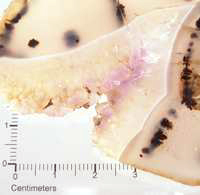 |
Yes, that purple area is amethyst in a Montana agate ! ! Tiny, sucrose quartz crystals are in the area between the visible-size amethyst and quartz crystals and the outermost agate (chalcedony) area. | ||||||
|
or small to large, interlocking crystals (massive, or "bull quartz"). |
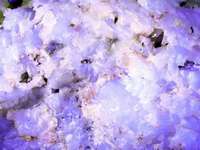 |
Bull quartz from Ouachita Mountains near Hot Springs, Arkansas. |
||||||
|
Macrocrystalline quartz crystals may contain inclusions (such as minerals that were trapped as the crystal grew, or "phantom" outlines of the crystal's former, smaller shape). |
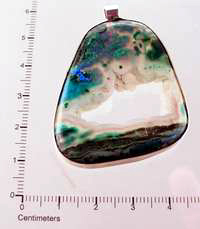 |
malachite - azurite in quartz |
||||||
|
Chalcedony can be divided into opaque forms (jasper, chert, flint, etc.) and translucent forms (agate). Agate has a number of distinctive, characteristic forms: (go back to top of page)
|
||||||||
| botryoidal (grapelike), |
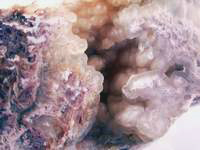 |
Botryoidal shapes in void space in vein agate from Graveyard Point, OR. | ||||||
|
mammillary (breastlike), |
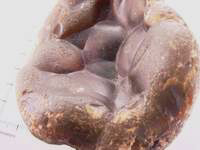 |
Montana agate, Yellowstone River, MT. Mammillary forms developed on a concave surface, which probably protected them from grinding by other rocks. | ||||||
| banded in parallel, irregular shapes (fortification agate), and |
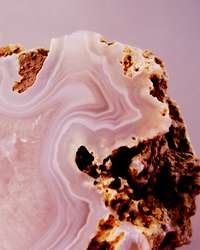 |
Fortification agate from Muldoon, ID. | ||||||
| banded in flat, parallel, patterns (onyx) |
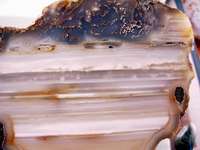 |
Agate from Muldoon, ID, mossy on top, onyx banding on bottom. | ||||||
| An agate or chert nodule's shape may also be affected by the space in which it developed. (go back to top of page) | ||||||||
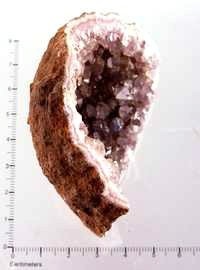 |
"Thunder-eggs" are spherical agates that develop in round openings (such as gas pockets in cooling lava). The interior of a thunder egg may contain fortification banding (suggesting that the agate spent most of its development below the groundwater table) or flat, parallel (onyx) banding (suggesting that the agate developed at a position that was periodically wet, periodically dry). Or, a geode may have a hollow interior, often lined by crystals. | |||||||
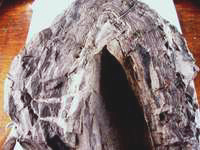 |
Silicate nodules, such as Kentucky agate and Central PA chert nodules, can also form in sedimentary rock. These form by convergent, chemical accumulation in bottom sediments in a marine environment, and often have a spherical or elliptical shape. Most are solid - very few have druzy interior openings like this chert nodule from central PA. | |||||||
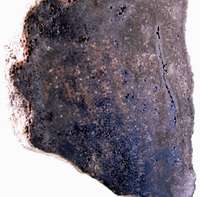 |
Sometimes silica in a marine sediment environment doesn't coalesce into nodules, but instead cements "beds" (flat, planar bedrock features) that may be chemically attractive to silica. Oolitic chert is the result of a sedimentary rock bed that originally formed by chemical precipitation in a low-energy marine environment and was then cemented by silica. | |||||||
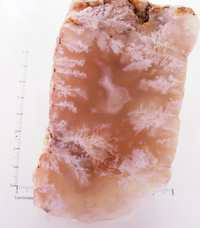 |
When hot water circulates into bedrock cracks or fractures, the result may be vein agate. This vein (plume) agate from SE Oregon took on its exterior shape from a wide opening in bedrock. This rock didn't travel far from its place of formation and didn't experience erosion or rounding, so the exterior is probably a pretty good "cast" of the space in which it developed. | |||||||
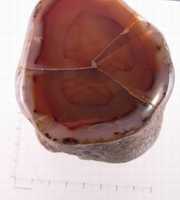 |
It's widely believed that some Montana agate was formed when silica-rich groundwater replaced minerals in branches and trunks that were buried by volcanic ash. The result is a "limb cast", which may have a cylindrical shape or else may have cylindrical interior banding. | |||||||
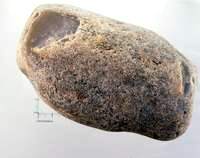 |
Agates found in river gravel or on beaches are generally rounded as a result of tumbling transport in flowing water. Montana agates often break along weak structures (botryoidal or fortification banding surfaces). If the original agate was large, then you may see just a small sliver of the original internal structure. | |||||||
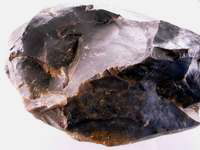 |
Chalcedony has a "conchoidal" (kon-CHOY-dal) fracture, which means that, if an angular stone is struck along an edge, fractures may propagate away from the point of impact in a curving, cone-like fashion. Early humans took advantage of this property to fashion stone tools. If you strike a round agate nodule, cracks may propagate through the agate in flat or gently-curving, near-planar shapes. Crack propagation may also be affected by weak structures in the agate. A crack may extend completely through an agate, in which case the stone is likely to fall apart, or the crack may pass only part-way through the stone and may subsequently be "healed" by silica deposition or colored by other mineral intrusion. | |||||||